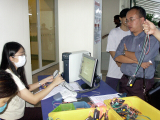June 4, 2003 – Radio frequency identification is playing a role in the global fight to contain Severe Acute Respiratory Syndrome, or SARS. Two hospitals in Singapore are now testing an RFID system that tracks the movement of staff, visitors and patients so they can trace all of the people with whom a suspected SARS patient had contact. “With this system, exact information on when a person enters or leaves a certain area is recorded automatically,” says Joshua Lee, program manager for the Defense Science & Technology Agency (DSTA), which developed the system. “When needed, information on the persons he could have been in contact with can be obtained quickly, using the search and query capability of the system.”
Since early May, Alexandra Hospital, the only public hospital in Singapore not to be touched by the SARS outbreak, has been testing the new Hospital Movement Tracking System in its accident and emergency department. The National University Hospital started a trial for its staff on May 23, and last week that was expanded to cover patients and visitors. All patients, visitors and staff who enter areas in the two hospitals where the trials are being conducted must provide their name and contact information at the registration counter, so they can be contacted later if necessary. They are then given a card with an embedded RFID transponder that has a small battery. Hospital employees have also been given ID cards with the transponders in them. The active devices continually transmit RFID signals at 433 MHz to readers placed around the facilities. The emergency department at Alexandra hospital is divided into several zones. A receiver has been installed in the ceiling of each zone.
The incubation period of the SARS virus is 10 days. The system is set up to store information on visitors for 21 days. This ensures that information about all the contacts a probable SARS patient had within the hospital remains available well after the incubation period ends. The confidential information is deleted from the system after 21 days. Singapore’s DSTA developed the system after it received a request from the Ministry of Health to explore ways of tracing contacts within a hospital should there be a suspected SARS case. DSTA evaluated several options, but quickly settled on RFID because of its ability to track people without interrupting operations in the hospital or requiring staff to do much additional work. The system was tested and did not interfere with hospital equipment.
DSTA worked with ST Electronics, a unit of Singapore’s ST Engineering. ST created the software that enables the system to track in real time when a person enters or leaves a certain zone. It also created back-end software that allows staff to query the database for information. Hospital staff can access the application through a Web-based portal on the hospital’s Intranet. If a patient is suspected of having SARS, staff can run an immediate check to find out who has had contact with the patient, in which zone and at what time. The system runs off of the hospital’s existing local area network and was built with off-the-shelf RFID tags and readers. It can track an unlimited number of people, but each reader can cope with no more than 100 RFID cards at one time.
During the initial introduction, there were some blind spots where the receivers couldn’t pick up the RF signal emitted by the cards. “The engineers had to fine-tune the receivers’ sensitivity to ensure adequate coverage for the entire emergency department,” says Lee. “If the receivers were too sensitive, there would be an overlap in the coverage. And if they weren’t sensitive enough, certain areas would not be covered.” The hospital handles about 250 emergency cases a day, with each patient allowed one visitor. There are also 36 doctors and nurses working in the department. Lee says the system has adequately tracked the movements and contacts of more than 500 people per day. Fortunately, there have been no SARS cases, so the system has not been needed to trace back contacts.


